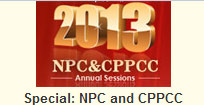Reforms moving with the times
Updated: 2013-03-11 07:57
By Hu Yongqi, Lan Lan, and Fu Jing (China Daily)
|
|||||||||||
In the same year, the State Environmental Protection Administration became the Ministry of Environmental Protection and its responsibilities were expanded to include a number of specific environmental and ecological challenges.
|
 |
These reductions and mergers inevitably led to a reduction in staff. The reforms of 1982 saw 39 ministries and departments cut, resulting in 21,000 officials leaving the central government payroll.
In 1998, the State Council was further streamlined, and approximately half its employees were moved to other departments and State-owned enterprises, resulting in lower administrative involvement in economic matters.
While the earlier reforms were driven by domestic market forces and the need for China to become more integrated with the global economy, the country can still learn the lessons of history, especially the experiences of Japan in the 1980s, said Bai Zhili, associate professor at the School of Government at Peking University.
At the time, Japan's economic and market control was highly bureaucratic and government involvement pushed forward the nation's economic takeoff, he said.
However, when the economy stopped growing in the 1990s, Japan's central government was forced to relinquish some of its power to local governments and privatize state-owned enterprises to stimulate the market. The reforms successfully prevented further economic deterioration, he said.
In addition to the market, there is also society. As social networking platforms such as micro blogs become more popular in China, the government will need to update the administrative model and pay greater attention to public opinion as a means of sustaining social stability and harmony, said Chi Fulin.
Dialogue mechanism
The government needs to further open the public services sector and encourage social forces, such as NGOs, to participate in the provision of public services. A dialogue mechanism should also be established to strengthen communication between government and society at large.
Public expectations for better living standards now revolve around high-quality housing, a higher standard of education and cleaner air, a much more demanding set of priorities from 20 years ago, when most people simply wanted warm housing and sufficient food, said He.
"The focus of institutional restructuring should gradually shift to building a harmonious relationship between the State and society, from rationalizing the relationship between the government and market," she said.
Departments providing social services accounted for 35 percent of State Council departments in 2007, while it was less than 30 percent in 1982, she said.
Related Stories
Officials worry over railway ministry's debts 2013-03-11 02:26
China to merge health ministry, family planning commission 2013-03-10 08:53
China to dismantle Railway Ministry 2013-03-10 08:50
China to merge press, broadcasting regulators 2013-03-10 08:59
Today's Top News
Police continue manhunt for 2nd bombing suspect
H7N9 flu transmission studied
8% growth predicted for Q2
Nuke reactor gets foreign contract
First couple on Time's list of most influential
'Green' awareness levels drop in Beijing
Palace Museum spruces up
Trading channels 'need to broaden'
Hot Topics
Lunar probe , China growth forecasts, Emission rules get tougher, China seen through 'colored lens', International board,
Editor's Picks

|

|

|

|

|

|





